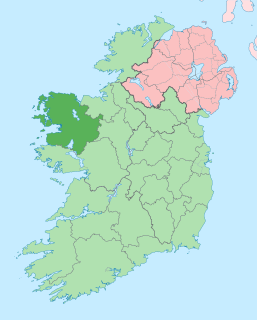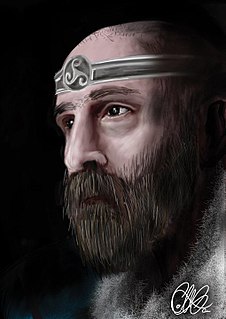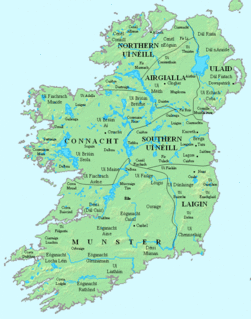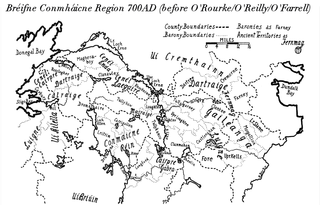The Gamanraige were the main branch of the Fir Ol nEchmacht, a people who ruled much of Ireland west of the Shannon in the pre-historic era.
The Gamanraige ruled the territory between the Gallimhe or Galway river, to the Drowes and Duff rivers in the north-east. Their capital was Rath Eochaidh, later called Cruchain. This territory seems to have been Ol nEchmacht proper. It was only with the rise of The Connachta dynasty that the term Fir Ol nEchmacht was dropped and the province was renamed Connacht.
The story of the Táin Bó Flidhais tells the tale of a raid by the Connachta tribe on the Gamanraige. Queen Medb, her husband Ailill and their guest from the Ulaidh, Fergus launched a raid on Flidhais and her husband Oilill Finn in Erris, North Mayo.

County Mayo is a county in Ireland. In the West of Ireland, in the province of Connacht, it is named after the village of Mayo, now generally known as Mayo Abbey. Mayo County Council is the local authority. The population was 130,507 at the 2016 census. The boundaries of the county, which was formed in 1585, reflect the Mac William Íochtar lordship at that time.

Connacht, formerly spelled Connaught, is one of the provinces of Ireland, in the west of Ireland. Up to the 9th century it consisted of several independent major kingdoms.

Medb —later forms Meḋḃ, Maedhbh and Méabh and also Maeve—is queen of Connacht in the Ulster Cycle of Irish mythology. Her husband in the core stories of the cycle is Ailill mac Máta, although she had several husbands before him who were also kings of Connacht. She rules from Cruachan. She is the enemy of Conchobar mac Nessa, king of Ulster, and is best known for starting the Táin Bó Cúailnge to steal Ulster's prize stud bull Donn Cúailnge.

Ailill mac Máta is the king of the Connachta and the husband of queen Medb in the Ulster Cycle of Irish mythology. He rules from Cruachan.
The Ulster Cycle, formerly known as the Red Branch Cycle, one of the four great cycles of Irish mythology, is a body of medieval Irish heroic legends and sagas of the traditional heroes of the Ulaid in what is now eastern Ulster and northern Leinster, particularly counties Armagh, Down and Louth, and taking place around or before the 1st century AD.

The Connachta are a group of medieval Irish dynasties who claimed descent from the legendary High King Conn Cétchathach. The modern western province of Connacht takes its name from them, although the territories of the Connachta also included at various times parts of southern and western Ulster and northern Leinster. Their traditional capital was Cruachan.
Flidas or Flidais is a female figure in Irish Mythology, known by the epithet Foltchaín. She is believed to have been a goddess of cattle and fertility.

Delbhna Tír Dhá Locha was a tuath of Gaelic Ireland, located in the west of Ireland in what is now Co. Galway.
Cóiced Ol nEchmacht is an ancient name for the province of Connacht, Ireland.
Fir Ol nEchmacht was the name of a group or race of people living in pre-historic Ireland. The name may be translated as "men of the race/people of Echmacht". Some scholars believe they are connected to, or the same as, the Nagnatae tribe, mentioned in Ptolemy's 2nd century AD work Geography.
Fir Craibe is a branch of the Fir Ol nEchmacht, one of the ancient peoples of Ireland.
The Tuatha Taiden were a branch of the Fir Ol nEchmacht, one of the ancient peoples of Ireland.

Nephin or Nefin, at 806 metres (2646 ft), is the highest standalone mountain in Ireland and the second-highest peak in Connacht, Ireland. It is to the west of Lough Conn in County Mayo. Néifinn is variously translated as meaning 'heavenly', 'sanctuary', or "Finn's Heaven".
Glencastle is a small village in the northwest of County Mayo, Ireland. The townland incorporates an area of 2,336 acres (9.45 km2).
Achtan, fl. c. 1st-2nd centuries AD, mother of Cormac mac Airt.

Táin Bó Flidhais, also known as the Mayo Táin, is a tale from the Ulster Cycle of early Irish literature. It is one of a group of works known as Táin Bó, or "cattle raid" stories, the best known of which is Táin Bó Cúailnge. Táin Bó Flidhais survives in two forms, a short version from the Old Irish period and a longer version found in the 15th century Glenmasan manuscript, which is held in the Advocates Library in Edinburgh. It is believed to be a copy of an earlier manuscript from the 12th century. The early version of Táin Bó Flidhais predates the Táin Bó Cúailnge. It is named for the heroine of the tale, Flidais.

Gailenga was the name of two related peoples and kingdoms found in medieval Ireland in Brega and Connacht.
The Uí Fiachrach were a royal dynasty who originated in, and whose descendants later ruled, the coicead or fifth of Connacht at different times from the mid-first millennium onwards. They claimed descent from Fiachrae, an older half-brother of Niall Noigiallach or Niall of the Nine Hostages. Fiachrae and his two full brothers, Brion and Ailill, were the collective ancestors of the Connachta dynasty that eventually became the new name of the province. Their mother was Mongfind.
This page is based on this
Wikipedia article Text is available under the
CC BY-SA 4.0 license; additional terms may apply.
Images, videos and audio are available under their respective licenses.






